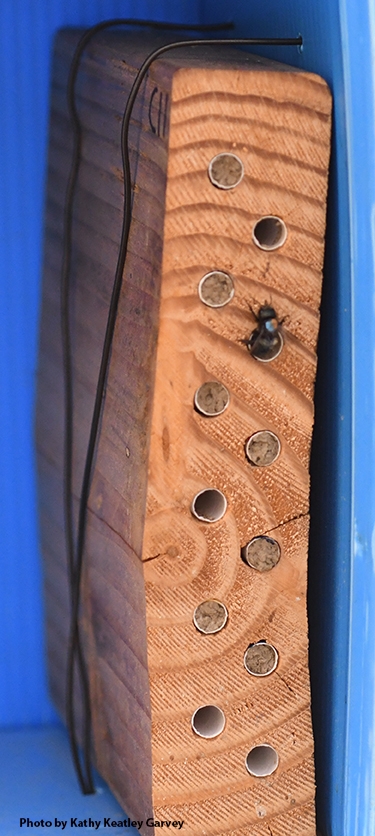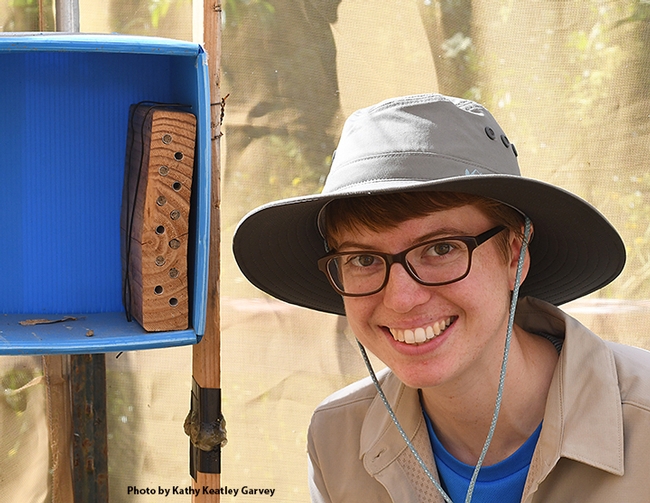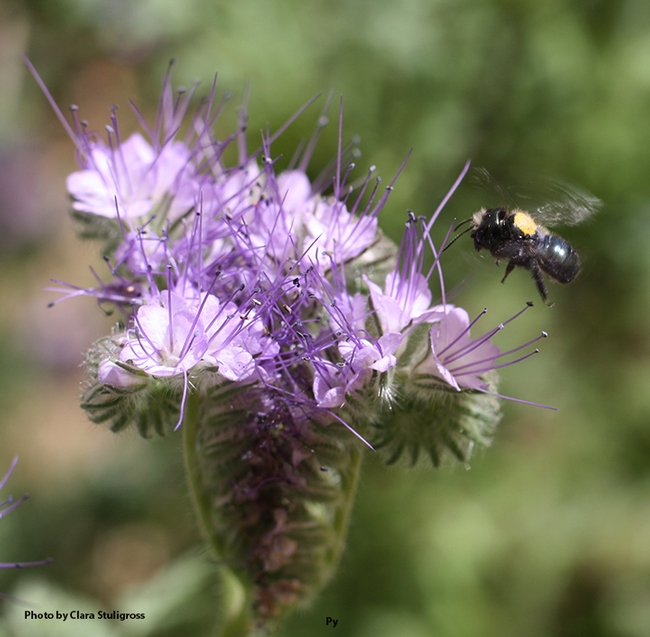
Lead author and doctoral student Clara Stuligross teamed with her major professor, pollination ecologist Neal Williams of the UC Davis Department of Entomology and Nematology, to publish Pesticide and Resource Stressors Additively Impair Wild Bee Reproduction, in the journal Proceedings of the Royal Society B.
They exposed the bees to the neonicotinoid insecticide imidacloprid, widely used in agriculture, and found that the combined threats—imidacloprid exposure and the loss of flowering plants—reduced the bee's reproduction by 57 percent, resulting in fewer female offspring.
Of the two stressors—food scarcity and pesticide exposure—pesticide exposure showed the great impact on nesting activity and the number of offspring produced, they said.
Other scientists have conducted similar research on honey bees, but this is the first comparable research on wild bees in field or semi-field conditions.
The blue orchard bee, nicknamed BOB, is a dark metallic mason bee, smaller than a honey bee. It is prized for pollinating almond, apple, plum, pear, and peach trees. California almond growers often set up bee boxes or "bee condos" for blue orchard bees to aid in honey bee pollination. In the wild, the bees nest in reeds or natural holes.
“Bees and other beneficial insects experience multiple stressors within agricultural landscapes that act together to impact their health and diminish their ability to deliver the ecosystem services on which human food supplies depend,” Stuligross and Williams wrote in their abstract. “Disentangling the effects of coupled stressors is a primary challenge for understanding how to promote their populations and ensure robust pollination and other ecosystem services.”
To study the survival, nesting and reproduction of the blue orchard bee, they set up nesting females in large flight cages, some with high densities of wildflowers and others with low densities that were treated “with or without the common insecticide, imidacloprid.” Bees are commonly exposed to insecticides when they forage on treated flowers.
“Pesticides and resource limitation acted additively to dramatically reduce reproduction in free-flying bees,” they wrote in their abstract. “Our results emphasize the importance of considering multiple drivers to inform population persistence, management, and risk assessment for the long-term sustainability of food production and natural ecosystems.”

Key factors in affecting bee reproduction are the probability that females will nest and the total number of offspring they have. The UC Davis research found that pesticide-exposed and resource-deprived female bees delayed the onset of nesting by 3.6 days and spent five fewer days nesting than unexposed bees.

They found that only 62 percent of pesticide-exposed bees produced at least one daughter compared to 92 percent of bees not exposed to pesticides.
The research, accomplished in the spring of 2018 on the grounds of the Harry H. Laidlaw Jr. Facility west of the campus, drew support from a UC Davis Jastro Research Award, a UC Davis Ecology Graduate Research Fellowship, a National Science Foundation Graduate Research Fellowship, and the UC Davis bee biology facility
The blue orchard bee bee is one of the few native pollinators that is managed in agriculture. North America has 140 species of Osmia, according to a Pollinator Partnership (PP) article in a U. S. Forest Service publication, authored by entomologist and PP member Beatriz Moisset and PP director Vicki Wojcik. “Mason bees use clay to make partitions and to seal the entrance,” they wrote. “This unique mud-building behavior leads to their common designation as mason bees. Honey bees are very important to commercial agriculture, but native bees like the blue orchard bees are better and more efficient pollinators of native crops.”
Imidacloprid, a systemic insecticide that acts as an insect neurotoxin, is used to control sucking insects, termites, some soil insects and fleas on pets, according to National Pesticide Information Center. It mimics nicotine, toxic to insects, which is naturally found in many plants, including tobacco. More than 400 products for sale in the United States contain imidacloprid.
Attached Images:

